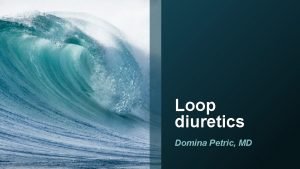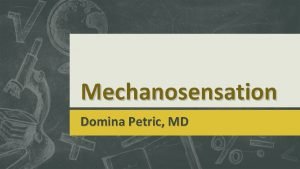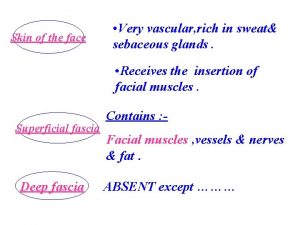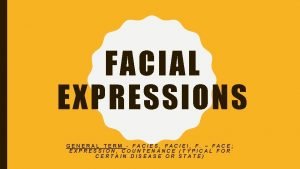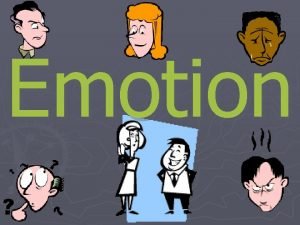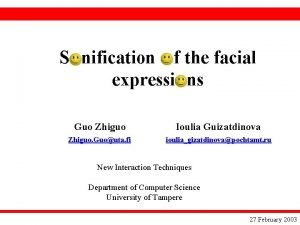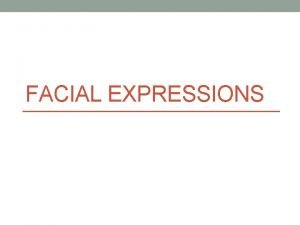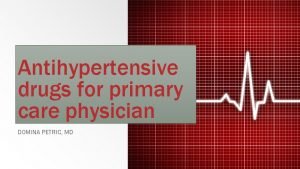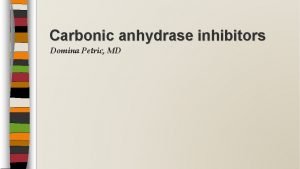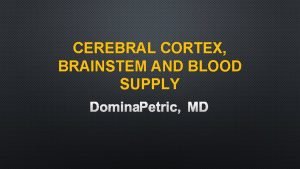Control of facial expressions Domina Petric MD Facial














- Slides: 14

Control of facial expressions Domina Petric, MD

Facial nerve, facial cortex �Facial nerve motor nucleus in the pons. �Facial colliculus around the abducens nucleus. �Inferior segment of the lateral part of precentral gyrus is governing the movements of the contralateral lower part of facial musculature. �Control for the upper part of the facial musculature is governed by a region along the mid -sagittal surface of the brain: in the cingulate sulcus, the cingulate motor area.

Middle cerebral artery lesion Causes contralateral facial weakness which is limited to the lower part of the face.

Cingulate motor area is supplied by anterior cerebral artery. Cingulate motor area provides bilateral innervation from upper motor neurons to the facial motor nucleus.

Infarcion in the middle cerebral artery region: inferior and lateral part of the precentral gyrus Even if one anterior cerebral artery is infarcted, upper parts of the facial musculature will be spared. Contralateral lower facial musculature weakness

Lesion of facial nerve (lower motor neuron lesion), for example, Bell´s palsy causes ipsilateral facial musculature weakness, both upper and lower parts of the face.

Volitional movement: descending pyramidal and extrapyramidal projections from motor cortex and brainstem Neural systems for emotional expression: descending extrapyramidal projections from medial forebrain and hypothalamus Voluntary facial paresis Emotional facial paresis Duchenne smile Pyramidal smile Motor neuron pools in facial nucleus Activation of facial muscles

PYRAMIDAL SMILE: SMILE IS MORE SYMMETRICAL WHEN THERE IS EMOTIONAL SMILE. DUCHENNE SMILE: SMILE IS ASYMMETRICAL WHEN THERE IS EMOTIONAL COMPONENT. http: //elisasylee. blogspot. hr/2006_07_01_archive. html Pyramidal smile Duchenne smile

Cranial nerves motor nuclei with significant contralateral bias in upper motor neuron innervation are: trigeminal motor nucleus (V) facial motor nucleus (VII) spinal accessory nucleus (XI) hypoglossal nucleus (XII)

II. UPPER MOTOR NEURON SYNDROME

Upper motor neuron syndrome In the early fase of the upper motor neuron damage patient may present with signs and symptoms that look like lower motor neuron injury. It is a spinal shock. Spinal shock: patients are weak, muscles appear to be flaccid, muscle tone and reflexes are reduced.

Upper motor neuron syndrome Second fase is typical for upper motor neuron syndrome (up to after one week from injury): • spastic muscles • pathological muscle tone • hyperreflexia

Upper motor neuron syndrome Lower motor neuron syndrome � weakness or paralysis � spasticity � decreased superficial � increased muscle tone � hyperactive deep reflexes � clonus � Babinski sign � loss of fine voluntary movements reflexes � hypoactive deep reflexes � decreased tone � fasciculations and fibrillations (early fase) � severe muscle atrophy Upper vs. lower motor neuron sy.

Literature �https: //www. coursera. org/learn/medical- neuroscience/lecture: Leonard E. White, Ph. D, Duke University �http: //images. clipartpanda. com �http: //elisasylee. blogspot. hr



